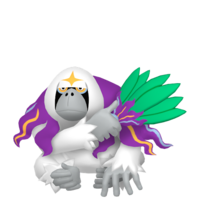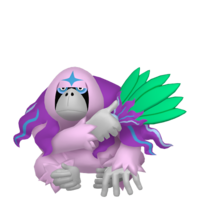From Bulbapedia, the community-driven Pokémon encyclopedia.
|
|
| Line 88: |
Line 88: |
| {{Availability/Entry1|v=Moon|area=[[Lush Jungle]]}} | | {{Availability/Entry1|v=Moon|area=[[Lush Jungle]]}} |
| {{Availability/Entry1/None|v=Ultra Sun|area=[[Trade]], [[#In events|Event]]}} | | {{Availability/Entry1/None|v=Ultra Sun|area=[[Trade]], [[#In events|Event]]}} |
| {{Availability/Entry1|v=Ultra Moon|area=[[Lush Jungle]]}} | | {{Availability/Entry1|v=Ultra Moon|t=FFF|area=[[Lush Jungle]]}} |
| {{Availability/Entry2/None|v=Let's Go Pikachu|v2=Let's Go Eevee|area=Unobtainable}} | | {{Availability/Entry2/None|v=Let's Go Pikachu|v2=Let's Go Eevee|area=Unobtainable}} |
| |} | | |} |
| Line 94: |
Line 94: |
| {{Availability/Gen|gen=VIII}} | | {{Availability/Gen|gen=VIII}} |
| {{Availability/Entry1/None|v=Sword}} | | {{Availability/Entry1/None|v=Sword}} |
| {{Availability/Entry1|v=Shield|area=[[Glimwood Tangle]]<br>[[Rolling Fields/Dens|Rolling Fields]], [[East Lake Axewell/Dens|East Lake Axewell]], [[Motostoke Riverbank/Dens|Motostoke Riverbank]], [[Bridge Field/Dens|Bridge Field]], [[Stony Wilderness/Dens|Stony Wilderness]] ([[Max Raid Battle]])}} | | {{Availability/Entry1|v=Shield|t=FFF|area=[[Glimwood Tangle]]<br>[[Rolling Fields/Dens|Rolling Fields]], [[East Lake Axewell/Dens|East Lake Axewell]], [[Motostoke Riverbank/Dens|Motostoke Riverbank]], [[Bridge Field/Dens|Bridge Field]], [[Stony Wilderness/Dens|Stony Wilderness]] ([[Max Raid Battle]])}} |
| {{Availability/Entry1|v=Sword Expansion Pass|color={{sword color dark}}|t=fff|link=Pokémon Sword and Shield Expansion Pass|area=[[Max Lair]] ([[Dynamax Adventure]])}} | | {{Availability/Entry1|v=Sword Expansion Pass|color={{sword color dark}}|t=fff|link=Pokémon Sword and Shield Expansion Pass|area=[[Max Lair]] ([[Dynamax Adventure]])}} |
| {{Availability/Entry1|v=Shield Expansion Pass|color={{shield color dark}}|t=fff|link=Pokémon Sword and Shield Expansion Pass|area=[[Forest of Focus]]<br>[[Max Lair]] ([[Dynamax Adventure]])}} | | {{Availability/Entry1|v=Shield Expansion Pass|color={{shield color dark}}|t=fff|link=Pokémon Sword and Shield Expansion Pass|area=[[Forest of Focus]]<br>[[Max Lair]] ([[Dynamax Adventure]])}} |
Revision as of 21:12, 1 June 2024
Oranguru (Japanese: ヤレユータン Yareyuutan) is a dual-type Normal/Psychic Pokémon introduced in Generation VII.
It is not known to evolve into or from any other Pokémon, but it is considered to be a counterpart of Passimian.
Biology
Oranguru is a simian Pokémon resembling an orangutan. While most of its body is covered in white fur, its hands, feet, and snout are bare with its light gray skin visible. The fur around its head and under its chin is longer and creates the impression of a long beard. It has a broad, flat nose and a black area around its eyes. Underneath each eye is a yellow ring marking, which is encircled by a light blue ring marking. In the center of its forehead is a yellow marking shaped like a four-pointed star. A cape of purple fur covers its back and is divided into many wavy clumps with strands of orange and light blue throughout. The purple fur grows longer as it ages. Oranguru holds a fan created from green leaves woven together with its own purple fur.
This solitary Pokémon spends its time deep in the forest, meditating high up in the trees. While it is not normally active, it will provide food to hungry Pokémon and give medicine to injured ones. It has even been known to use human tools or items, including Poké Balls. It has a lofty attitude and will give other Pokémon orders. This can make them difficult Pokémon for Trainers to handle. Ancient people actually thought Oranguru were people and called them the "people of the forests."[1] Oranguru does not get along with others of its kind, often battling out their wits for superiority. It will also occasionally venture to the beach to match wits with Slowking.
Oranguru is the only known Pokémon capable of learning the move Instruct. Additionally, in Generation VIII, Oranguru was the only known Pokémon that could have Symbiosis as an Ability.
Game data
Pokédex entries
| This Pokémon was unavailable prior to Generation VII.
|
| Generation VII
|
|
Alola
S M : #176
|
|
Alola
US UM : #215
|
|
Kanto
#—
|
| This Pokémon has no Pokédex entries in Let's Go, Pikachu! and Let's Go, Eevee!.
|
| Sun
|
Known for its extreme intelligence, this Pokémon will look down on inexperienced Trainers, so it's best suited to veteran Trainers.
|
| Moon
|
Deep in the jungle, high in the lofty canopy, this Pokémon abides. On rare occasions, it shows up at the beach to match wits with Slowking.
|
| Ultra Sun
|
It normally spends its time meditating in the treetops. It throws Poké Balls and gives other Pokémon orders as it pleases.
|
| Ultra Moon
|
Oranguru don't get along with each other, so they're always engaging in battles of wits to decide which one is superior.
|
|
|
|
|
| Generation IX
|
|
Paldea
#313
|
|
Kitakami
#—
|
|
Blueberry
#—
|
| Scarlet
|
People used to mistake Oranguru for a human when they saw it issue command after command to the other Pokémon of the forest.
|
| Violet
|
This Pokémon lives quietly in the depths of the forest. The purple, cape-like fur gets longer and longer as Oranguru ages.
|
|
|
Game locations
| This Pokémon was unavailable prior to Generation VII.
|
|
|
|
|
|
|
In side games
| This Pokémon was unavailable prior to Generation VII.
|
| Generation VII
|
|
| This Pokémon is unavailable in Generation VII side games.
|
|
|
| Generation VIII
|
|
| This Pokémon is unavailable in Generation VIII side games.
|
|
|
|
|
In events
Held items
Stats
Base stats
| Stat
|
Range
|
| At Lv. 50
|
At Lv. 100
|
90
|
|
150 - 197
|
290 - 384
|
60
|
|
58 - 123
|
112 - 240
|
80
|
|
76 - 145
|
148 - 284
|
90
|
|
85 - 156
|
166 - 306
|
110
|
|
103 - 178
|
202 - 350
|
60
|
|
58 - 123
|
112 - 240
|
Total: 490
|
Other Pokémon with this total
|
- Minimum stats are calculated with 0 EVs, IVs of 0, and (if applicable) a hindering nature.
- Maximum stats are calculated with 252 EVs, IVs of 31, and (if applicable) a helpful nature.
|
Type effectiveness
| Under normal battle conditions in Generation IX, this Pokémon is:
|
|
|
|
|
|
|
|
|
|
|
|
|
Learnset
|
|
|
|
- Bold indicates a move that gets STAB when used by Oranguru
- Italic indicates a move that gets STAB only when used by an Evolution of Oranguru
- Click on the generation numbers at the top to see level-up moves from other generations
|
|
|
|
|
- Bold indicates a move that gets STAB when used by Oranguru
- Italic indicates a move that gets STAB only when used by an Evolution or an alternate form of Oranguru
- Click on the generation numbers at the top to see TM moves from other generations
|
|
|
|
|
- Moves marked with an asterisk (*) must be chain bred onto Oranguru
- Bold indicates a move that gets STAB when used by Oranguru
- Italic indicates a move that gets STAB only when used by an Evolution of Oranguru
|
Side game data
Evolution data
Sprites
| This Pokémon was unavailable prior to Generation VII.
|
|
|
|
|
|
|
In the anime
Major appearances
Oranguru debuted in Mallow and the Forest Teacher!, where it helped Mallow after she was injured while running away from home. Oranguru runs a small café in the forest near Hau'oli City and was revealed to have helped Mallow's father Abe when he was younger.
Minor appearances
Pokédex entries
| Episode
|
Pokémon
|
Source
|
Entry
|
| SM039
|
Oranguru
|
James's book
|
Oranguru, the Sage Pokémon. A Normal and Psychic type. Known for high intelligence, Oranguru have a tendency to be callous toward an inexperienced Trainer.
|
|
In the manga
Pokémon Adventures
Oranguru debuted in Homecoming and the Brilliant Professional Golfer, where it was seen in Lush Jungle.
An Oranguru appeared in Confusion and Monsters from Another World, as the Aether House headmaster.
An Oranguru appeared in Thump!! The Gazing Sage, where he was attacking Sonia before Henry successfully calmed him down and subsequently caught him, nicknaming him Fanguru.
In the TCG
- Main article: Oranguru (TCG)
Trivia
Origin
Oranguru appears to be based on an orangutan and a guru. The name "orangutan" translates as "person of the forest", which Oranguru has also been referred to as. Oranguru's Psychic typing and demeanor may reference the orangutan's high intelligence. Oranguru may also be based on the mythical satori, an ape-like yōkai that could read human minds.
The yellow symbol on Oranguru's head recalls the window of Caesar's room in the movie
Rise of the Planet of the Apes, and may be a direct inspiration.
Name origin
Oranguru may be a combination of orangutan and guru.
Yareyuutan may be a combination of やれ yare ("Do it") and オランウータン oran'ūtan (orangutan).
In other languages
| Language
|
Title
|
Meaning
|
 Japanese Japanese
|
ヤレユータン Yareyuutan
|
From やれ yare and オランウータン oran'ūtan
|
 French French
|
Gouroutan
|
From gourou and orang-outan
|
 Spanish Spanish
|
Oranguru
|
Same as English name
|
 German German
|
Kommandutan
|
From Kommando and Orang-Utan
|
 Italian Italian
|
Oranguru
|
Same as English name
|
 Korean Korean
|
하랑우탄 Harang-utan
|
From 하라 Hara and 오랑우탄 orang-utan
|
 Mandarin Chinese Mandarin Chinese
|
智揮猩 / 智挥猩 Zhìhuīxīng
|
From 智慧 zhìhuì, 指揮 / 指挥 zhǐhuī, 智多星 zhìduōxīng, and 猩猩 xīngxīng
|
 Cantonese Chinese Cantonese Chinese
|
智揮猩 Jifāisīng
|
From 智慧 jiwaih, 指揮 jífāi,, 智多星 jidōsīng, and 猩猩 sīngsīng
|
|
|
|
| More languages
|
 Hindi Hindi
|
ओरैंगुरू Oranguru
|
Transcription of English name
|
 Russian Russian
|
Орангуру Oranguru
|
Transcription of English name
|
 Thai Thai
|
ยาเรยูตัน Yareyutan
|
Transcription of Japanese name
|
|
|
|
Related articles
References
External links

|
This Pokémon article is part of Project Pokédex, a Bulbapedia project that aims to write comprehensive articles on each Pokémon species, as well as Pokémon groups and forms.
|


 For other sprites and images, please see Oranguru images on the Bulbagarden Archives.
For other sprites and images, please see Oranguru images on the Bulbagarden Archives.













